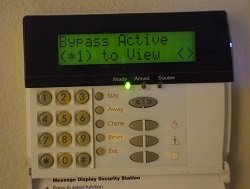- Home
- Compare Systems
- Cheap Systems
- Free Quotes
- DIY Systems
- Hardwired Systems
- Wireless Systems
- Smoke Detectors
- Medical Alarms
- Alarm Monitoring
- Cameras & Video
- Ademco
- ADT Security
- Brinks Security
- Broadview
- DSC Security
- FBI Alarms
- GE Security
- Honeywell
- Link Interactive
- Monitronics
- Moose
- Napco
- Protection 1
- Radionics
- Simplisafe
- Alarm Manuals
- Alarm System Parts
- Alarm Tools
- Troubleshooting
- FAQ
- Glossary
- Sitemap
- About Me
- Contact Me
How to Use Opening and Closing Reports
Opening and closing reports are the signals sent by an alarm panel to indicate the system has been disarmed (opening) or armed (closing). The terms carry over from the days when businesses were the primary users of alarm systems, and it was necessary to know when a store opened and closed each day. Note that this open and close communication is not the same as how you open and close a door, window, etc.
Nearly all security systems have the ability to send opening/closing reports, and many offer advanced features that make these signals very useful for owners of residential alarm systems.
If you have a babysitter, cleaning service, or other regular
visitors with access to your home, you might want to be able to verify
when they arrive and leave. Opening and closing reports do just that.
Case in Point:
I know of one alarm customer of mine who noticed her cleaning crew had
arrived and left within just one hour, based on the alarm opening and
closing signals. This was hardly enough time to do the thorough cleaning
job they were billing my customer for.
Needless to say, they “came clean” when confronted with the alarm reports!
Opening and closing reports also allow you to verify that
everyone with access to your house is in fact using the
alarm system. Large gaps of time between an opening and the following
closing can indicate that someone is failing to arm the system on
leaving.
There are several types of open/close reports, and each can be useful in different ways.
Basic Opening and Closing Reports
If you own a business, knowing when the alarm is armed and disarmed is probably something you’d like to know. Many homeowners (who may also be business owners) also want to keep track of when their systems are turned on and off.
Basic or “straight” open/close reports provide a log of all arming and disarming activity, time stamped by the
receiver at the central monitoring station. Most systems allow you to
assign each user their own personal arm/disarm code. When someone uses
their code to open and close the system, their user number is also
reported. This allows you to track who enters and leaves the home, and
at which times.
Exception Opening and Closing Reports
For many home applications, sending opening and closing reports all the time isn’t needed. Another option available on most panels is known as exception opening and closing reports. Also known as “restricted” reports, this simply means that the alarm panel will only report unusual events: An opening report after an alarm, and a closing report with shunted zone.

Exception reports “weed out” the normal everyday activity, when there isn’t really anything unusual to report. Think of it as a “No news is good news” feature. However, if the alarm is tripped while being disarmed, an exception report on opening signal is sent. Likewise, if the system is armed with a zone bypassed (“shunted”), then an exception closing is sent.
Exception opening and closing reports are useful because they
may indicate a possible problem, either with the alarm system or its
users.
At opening time, a faulty entry door switch might not trigger a
delay for someone entering the house, causing the alarm to go off. At
closing time, a bad door or window switch could cause the system or user
to bypass the faulted zone, sending an exception closing signal.
Advanced Opening and Closing Options
On alarm panels with more advanced features, opening and closing
“windows” can be programmed. As long as the system is armed and
disarmed within specified open and close times of day, no report
is generated. But, if the system is accessed during off-hours, a report is sent. Reports can also trigger special handling instructions
to central station personnel, like calling the premises, a contact
person’s home or cell phone, etc.
Latchkey Reporting
A special kind of exception reporting is referred to as a Latchkey function. It specifically addresses the issue of “latchkey” children, who often arrive home from school to an empty house due to their parents’ work schedule.
A latchkey report is sent if the alarm system isn’t disarmed by a certain time of day. It can be
user-programmed to correspond to a child’s expected arrival time at
home. The Latchkey function is available on many newer panels as a
dedicated feature, but older panels with programmable opening and
closing windows can perform the same function.
Getting Open and Close Reports
Activity logs of opening and closing reports can be sent to a
business or homeowner on a monthly (or other) basis via email or snail
mail, or just logged in the central station system for future reference.
Security companies charge varying amounts for these services, so be
sure to get the details before you decide to start getting activity
reports.
All of the above refers to open/close reports sent by a monitored alarm panel reporting to a central station. But, what
if you don’t want monitoring?
Stand-Alone Reporting Options
Many panels are now offering alternate reporting methods that don’t require a central station, and instead provide cellphone, smartphone, pager, and other mobile notifications. This self monitoring option can allow you to receive virtually any combination of alarm, trouble, or opening/closing reports you might want directly to your phone or mobile device. And, best of all, it’s free!
These features will, of course, require a bit of set-up initially. You (or your alarm installer) will need to program which messages or notifications to send, along with any cellphone numbers needed to reach your devices. If you’re a do-it-yourselfer, be sure to test each type of signal carefully to make sure you can receive it properly on your mobile device.
Also, before you decide to “jump ship” on central station monitoring, be aware that you probably won’t qualify for any homeowners’ insurance discounts if your system reports strictly to a mobile device. Depending on your carrier, the savings on monthly monitoring may not be worth the trade-off of higher insurance premiums.
Learn more at Should You Self Monitor Your Alarm System?
Related Articles:
How to save money with Home Security Alarm Monitoring
Home Monitoring Systems Give Peace of Mind
Home Burglar Alarm Systems Monitoring - Not Always Necessary? Getting the most out of non-monitored systems.
Custom Security System Features
Return to Home Security Systems Answers from Opening and Closing Reports
Return to Home Alarm System Monitoring from Opening and Closing Reports
Note: Feel free to print any of the articles on this site for personal, non-commercial use. Just look for this button:
If you found this website especially helpful, you might want to consider making a small donation. Since 2011, AzAlarmGuy has been providing free help and advice on home security systems to all of those in need.
Your gift, in any amount, will help me keep this website a free resource for anyone needing help with alarm system issues or questions.
Disclosure
I receive affiliate commissions from some of the companies and products I discuss. These commissions don't change the price that you pay.
Rest assured that this compensation does not influence my recommendations. I only endorse products and services that I truly believe to be an honest value for you, as a visitor to my site.
For more details, see my full disclaimer.






